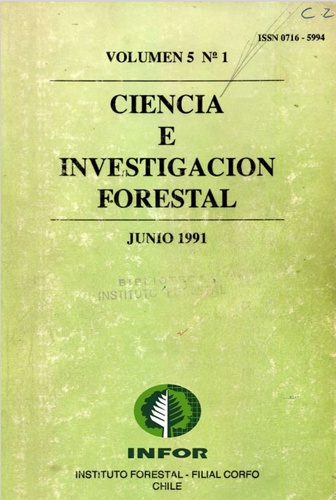Uso de la clasificación estructural mecánica y visual para predecir la zona de ruptura de la madera sometida a compresión
Barra lateral del artículo
Contenido principal del artículo
Resumen
Se realizó un estudio para determinar la exactitud de la clasificación estructural mecánica y de la clasificación estructural visual para predecir la zona de ruptura de una pieza de madera sometida a compresión. Usando parámetros relacionados con la clasificación estructural mecánica se obtuvo un 42% de exactitud en la predicción de la zona de ruptura, usando parámetros relacionados con la clasificación estructural visual se obtuvo un 56% de exactitud. Sin embargo, la exactitud aumentó a un 68% cuando se consideraron ambos parámetros a la vez. Esto demostró que para lograr en la práctica un eficiente proceso de clasificación ambos sistemas deben ser aplicados en línea en un aserradero.
Referencias
American Society for Testing and Materials (ASTM). (1990). Statics tests of timbers in structural sizes. ASTM D198-84 Annual Book of ASTM Standards. Philadelphia, Pa.
Campos, A. (1990). Compressive strength of softwood lumber loaded parallet to grain. IUFRO Timber Engineering Group S5.02 Meeting. Saint John, N.B. July-August, 1990.
Fewell, A.R. (1984). Timber stress grading machines. Building Research Establishment lnformation Paper N°17/84. Watford, England.
Gerhards, C.C. (1982). Longitudinal stress waves for lumber stress grading: factors affecting applicalions: state of the art. Forest Products Journal, 32(2): 20-25.
Jayne, B.A. (1959). Vibrational properties of Wood as índices of quality. Forest Products Jounal, 9(11): 411-416.
Lam, F. & Varoglu, E. (1990). Length effect on the performance of lumber in tension. Canadian Joumal of Civil Engineering, 17(10): 911-918. https://doi.org/10.1139/l90-103
Logan, J.D. (1990). Getting started with machine stress rating. Paper presented to Sawmill Techology for the 1990’s. Forintek. Canada Corporation. Sault Ste Marie, Ontario.
Madsen, B. (1990). Length effect in 38 mm spruce-pine-fir dimensión lumber. Canadian Journal of Civil Engineering, 17(2): 226-237. https://doi.org/10.1139/l90-028
Miller, D,G. & Tardif, Y. (1967). Development of a vibration grader and comparison of vibration grading with visual and mechanical grading. Forestry Branch, Dept. of Forestry and Rural Development, Departmental Publication N° 1208.
National Lumber Grades Authority (NLGA). (1987). Standard Grading Rules for Canadian Lumber. Vancouver, B.C.
Pellerin, R.F. (1965). A vibrational approach to non destructive testing of structural lumber. Forest Product Journal, 15(3): 93-101.
Samson, M. (1988). Transverse scanning for automatic detection of general slope of grain in lumber. Forest Products Journal, 38(7/8): 33-38.
Samson, M. (1989). Status of machine stress-rating of lumber 25 years after comercial implementation. Forest Products Journal, 39(11/12): 49-52.
Weibull, W. (1939 a). A statistical theory of the strength of materials. Royal Swedish Institute for Engineering Research, Proceedings N° 141. 45 p.
Weibull, W. (1939 b). The phenomenon of ruptura in solids. Royal Swedish Institute for Engineering Research, Proceeding N° 153. 55 p.
Wilson, T.R. (1921). The effect of spiral grain on the strength of wood. Journal of Forestry, XIX(7): 740-747.
Zhou, B. (1989). The influences of drying, knots and slope of grain on bending properties of White spruce. MSc. Thesis. University of New Brunswick, Department of Forest Engineering. Fredericton, N.B.
Descargas
Los trabajos publicados en Ciencia & Investigación Forestal se rigen por la licencia Creative Commons Atribución 4.0 Internacional (CC BY 4.0).

En lo esencial esta licencia involucra que los autores conservan sus derechos de autor, y que los lectores puedan de forma gratuita descargar, almacenar, copiar y distribuir la versión final aprobada y publicada del trabajo, siempre y cuando se realice sin fines comerciales y se cite la fuente y autoría de la obra.
